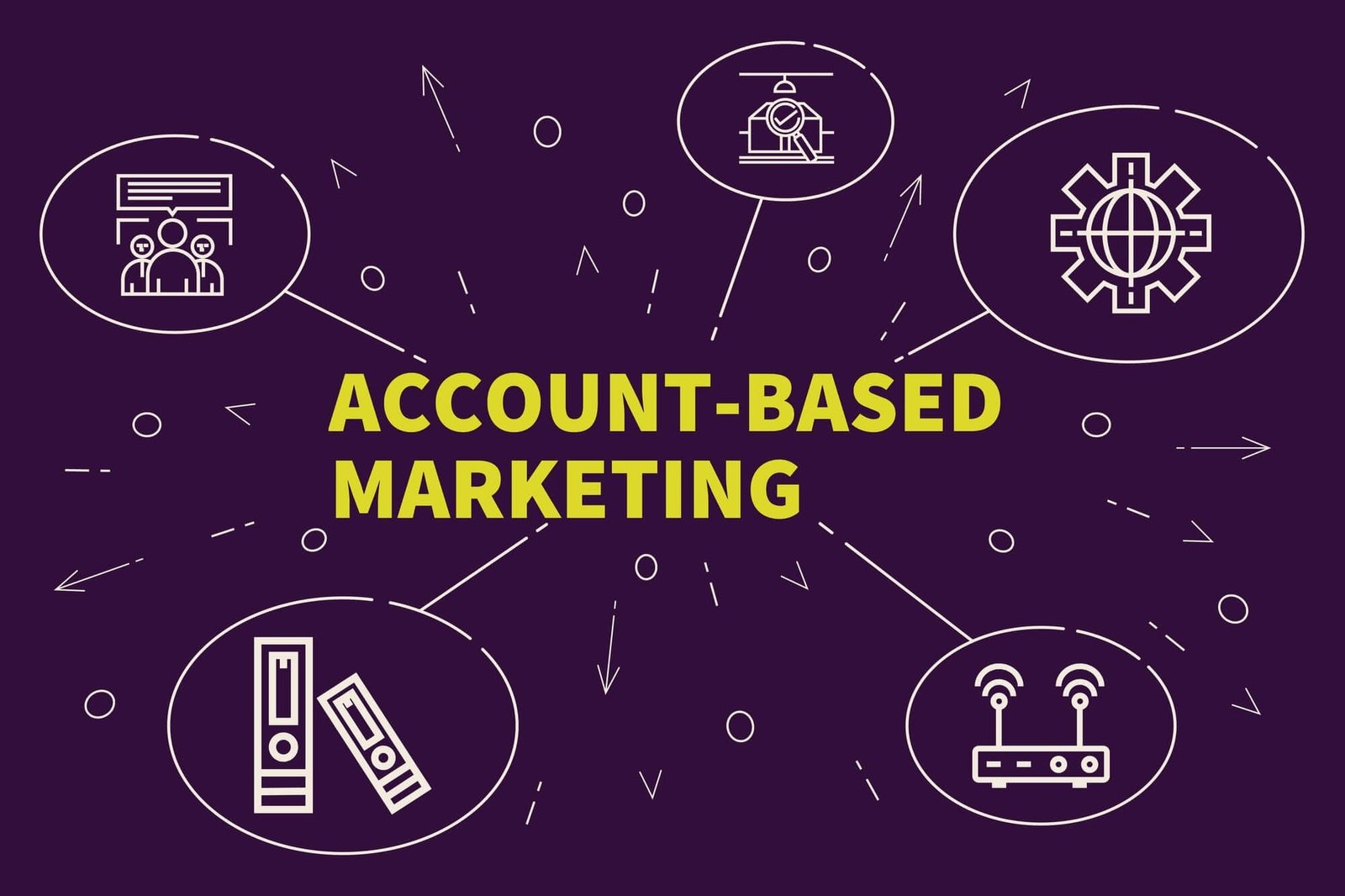Account-Based Marketing (ABM) is a highly targeted business strategy where marketing and sales teams work together to focus on specific high-value accounts. Instead of casting a wide net to attract potential leads, ABM zeroes in on key accounts that are the best fit for your product or service. This personalized approach can lead to higher conversion rates, better customer relationships, and increased revenue. Let’s dive into effective strategies for implementing ABM that will help you achieve these results.
Understanding Account-Based Marketing
Defining Your Ideal Customer Profile
To start with ABM, you need to define your ideal customer profile (ICP). This involves identifying the characteristics of companies that would benefit most from your product or service.
Consider factors like company size, industry, location, and annual revenue. Understanding these attributes will help you target the right accounts and tailor your marketing efforts to meet their specific needs.
Aligning Sales and Marketing Teams
One of the key aspects of ABM is the alignment between sales and marketing teams. Both teams must work closely to identify target accounts, develop personalized campaigns, and track progress.
Regular communication and collaboration are essential. Schedule joint meetings to discuss strategies, share insights, and ensure everyone is on the same page. This alignment ensures that your messaging is consistent and that both teams are working towards the same goals.
Researching Target Accounts
In-depth research is crucial for successful ABM. Gather detailed information about your target accounts, including their business goals, challenges, and decision-making processes.
Use this data to create personalized content and campaigns that address their specific needs. Tools like LinkedIn, company websites, and industry reports can provide valuable insights. The more you know about your target accounts, the better you can tailor your approach to resonate with them.
Crafting Personalized Campaigns
Creating Customized Content
Personalization is at the heart of ABM. Create content that speaks directly to the needs and pain points of your target accounts. This could include blog posts, whitepapers, case studies, and videos that address their specific challenges.
Use the information gathered during your research to tailor your content. For example, if a target account is struggling with supply chain management, create a case study showing how your product helped another company improve their supply chain efficiency.
Leveraging Multi-Channel Marketing
To reach your target accounts effectively, use a multi-channel approach. This means engaging them through various channels such as email, social media, direct mail, and events.
Each channel should deliver a consistent message but tailored to the format of that channel. For instance, use email to share detailed whitepapers, social media to engage with relevant posts, and direct mail for personalized gifts or handwritten notes. This approach ensures that your message is seen and remembered.
Implementing Account-Specific Landing Pages
Create landing pages specifically for your target accounts. These pages should be highly personalized, addressing the unique needs and challenges of each account.
Use their logos, mention their industry-specific issues, and highlight how your product can solve their problems. Personalizing landing pages can significantly increase engagement and conversion rates by making the visitor feel valued and understood.
Engaging Decision Makers
Building Relationships with Key Stakeholders
Engaging with decision makers within your target accounts is crucial for ABM success. Identify the key stakeholders and find ways to connect with them.
This might involve engaging with their content on LinkedIn, attending the same industry events, or reaching out with personalized messages. The goal is to build a relationship based on trust and mutual understanding. Personalize your communication by referencing specific challenges they face and how your solution can help.
Hosting Exclusive Events
Organizing exclusive events for your target accounts can be a powerful way to build relationships and demonstrate your value. These events could be webinars, roundtable discussions, or private dinners.
Invite key stakeholders and provide valuable insights that address their specific needs. Exclusive events create a sense of importance and allow for more meaningful interactions.
Offering Personalized Demos and Consultations
Provide personalized demos and consultations to your target accounts. Tailor these sessions to address their specific challenges and show how your product can meet their needs.
Personalized demos can significantly increase the chances of conversion by demonstrating your commitment to solving their problems. Follow up with detailed reports and recommendations based on the demo or consultation to keep the conversation going.
Leveraging Technology and Tools
Integrating CRM Systems
A robust CRM system is essential for effective ABM. Integrate your CRM with your marketing and sales tools to streamline data sharing and improve collaboration. Use the CRM to track interactions with your target accounts, manage your pipeline, and monitor the progress of your campaigns.
A well-integrated CRM system provides a centralized view of your ABM efforts, helping you stay organized and focused. It also allows for more personalized communication and tracking of individual account activities, which is crucial for maintaining detailed and accurate records of each account’s journey.
Utilizing Data Analytics Platforms
Data analytics platforms can provide deep insights into your ABM campaigns. Use these tools to analyze customer behavior, track engagement metrics, and measure the ROI of your campaigns.
Advanced analytics can help you identify trends and patterns that can inform your strategies. For example, you might discover that certain types of content are particularly effective at engaging specific accounts, or that particular channels yield higher conversion rates.
Use these insights to refine your campaigns and allocate resources more effectively.
Implementing Marketing Automation
Marketing automation tools can streamline many aspects of your ABM strategy, from email marketing to lead nurturing. Use these tools to automate repetitive tasks, such as sending follow-up emails or scheduling social media posts.
Automation ensures consistency in your outreach and allows you to maintain regular contact with your target accounts without overwhelming your team. Additionally, it enables you to set up complex, multi-step workflows that can guide prospects through the sales funnel based on their behavior and interactions.
Leveraging AI and Machine Learning
Artificial Intelligence (AI) and machine learning can enhance your ABM efforts by providing predictive insights and automating decision-making processes.
Use AI to analyze vast amounts of data and identify the most promising accounts, predict customer behavior, and personalize your marketing messages. Machine learning algorithms can continuously learn from data and improve the accuracy of your targeting and personalization efforts over time.
Creating Interactive Content
Interactive content can engage your target accounts more effectively than static content. Consider creating interactive tools such as calculators, quizzes, or assessments that provide personalized insights or recommendations.
This type of content not only captures attention but also provides value to your audience, making them more likely to engage with your brand. Interactive content can be tailored to address the specific needs and challenges of your target accounts, enhancing the personalization of your ABM efforts.
Developing a Strong Content Strategy
Mapping Content to the Buyer’s Journey
Develop a content strategy that aligns with the different stages of the buyer’s journey. Create content that addresses the needs and questions of your target accounts at each stage, from awareness to consideration to decision.
For example, use blog posts and whitepapers to attract and educate potential customers during the awareness stage, case studies and testimonials to build trust during the consideration stage, and personalized demos and consultations to close deals during the decision stage.
Mapping content to the buyer’s journey ensures that you provide the right information at the right time, helping to move prospects through the funnel more efficiently.
Creating Account-Specific Content
In ABM, personalization is key. Develop content specifically tailored to the unique needs and challenges of each target account. This could include customized case studies, industry-specific whitepapers, or personalized video messages.
Account-specific content demonstrates your deep understanding of the account’s business and shows that you are committed to addressing their specific pain points. This level of personalization can significantly increase engagement and conversion rates.
Using a Variety of Content Formats
Different people consume content in different ways, so it’s important to offer a variety of content formats. This could include blog posts, whitepapers, eBooks, videos, infographics, webinars, and podcasts. By providing content in multiple formats, you can cater to the preferences of different decision-makers within your target accounts.
For example, some may prefer reading detailed reports, while others might engage more with visual content or interactive webinars.
Promoting Content Across Multiple Channels
Distribute your content across multiple channels to maximize its reach and impact. Use your website, email newsletters, social media platforms, and third-party publications to share your content with your target accounts.
Tailor your distribution strategy to the preferences and behaviors of your target accounts. For example, if your research indicates that your target accounts are active on LinkedIn, focus on promoting your content through LinkedIn posts, InMail messages, and sponsored content.
Measuring Content Performance
Regularly analyze the performance of your content to determine what’s working and what isn’t. Use analytics tools to track metrics such as page views, time on page, social shares, and conversion rates.
This data can help you understand which types of content resonate most with your target accounts and which channels are most effective for distribution. Use these insights to continuously refine your content strategy and ensure that you are delivering the most relevant and valuable content to your audience.
Nurturing Relationships with Target Accounts

Personalized Outreach
Personalized outreach is critical in ABM. Use the insights gathered from your research and data analysis to craft personalized messages for your target accounts.
Reference specific pain points, industry trends, or recent company news to show that you have done your homework and understand their unique needs. Personalized outreach can include emails, phone calls, direct mail, and social media interactions.
The goal is to build a relationship based on trust and mutual understanding.
Regular Check-Ins
Maintaining regular contact with your target accounts is essential for building strong relationships. Schedule regular check-ins to provide updates, share new insights, and offer additional value.
These check-ins can be conducted through various channels, including phone calls, video meetings, or in-person visits. Regular communication helps you stay top-of-mind with your target accounts and demonstrates your ongoing commitment to their success.
Providing Value-Added Services
Go beyond your core offerings by providing value-added services that can help your target accounts achieve their goals. This could include providing market research, offering training sessions, or sharing best practices and industry insights.
By consistently providing additional value, you strengthen your relationship with your target accounts and position yourself as a trusted advisor.
Building a Community
Create a community around your brand where your target accounts can connect, share insights, and learn from each other. This could be an online forum, a LinkedIn group, or regular networking events.
Building a community fosters a sense of belonging and loyalty among your target accounts. It also provides a platform for you to engage with them on an ongoing basis and gather valuable feedback.
Building a Community
Creating Online Forums and Groups
Building an online forum or group can help foster a sense of community among your target accounts. Platforms like LinkedIn, Facebook, or even dedicated community forums on your website can serve as spaces for your customers to connect, share insights, and learn from each other.
Facilitate discussions by posting relevant topics, encouraging participation, and moderating the conversation to ensure it remains productive and valuable. By hosting a community where members feel heard and valued, you enhance their engagement with your brand and build stronger relationships.
Hosting Networking Events
Organize both virtual and in-person networking events that bring your target accounts together. These events could include industry roundtables, panel discussions, or informal meet-and-greet sessions.
Provide opportunities for attendees to share their experiences, discuss industry trends, and build professional connections. Hosting these events positions your company as a thought leader and a facilitator of valuable industry relationships, which can enhance your brand’s reputation and strengthen your connections with key accounts.
Sharing Best Practices and Case Studies
Regularly share best practices and success stories within your community. Highlight case studies that showcase how different accounts have successfully used your product or service to achieve their goals.
Provide detailed insights into the strategies they used and the results they achieved. This not only provides valuable information to your community members but also demonstrates the tangible benefits of your offerings. Sharing success stories helps build credibility and trust in your brand.
Providing Exclusive Content and Resources
Offer exclusive content and resources to members of your community. This could include advanced whitepapers, detailed industry reports, or early access to new product features.
By providing valuable, exclusive content, you incentivize participation in the community and keep members engaged. Additionally, this approach positions your brand as a leading source of industry knowledge and innovation.
Facilitating Peer-to-Peer Learning
Encourage peer-to-peer learning by creating opportunities for your community members to share their expertise and experiences. This could involve setting up mentorship programs, facilitating small group discussions, or organizing peer-led webinars.
Peer-to-peer learning not only adds value to the community but also strengthens the bonds between members. It creates a collaborative environment where everyone benefits from shared knowledge and experiences.
Gathering and Acting on Feedback
Regularly gather feedback from your community members to understand their needs, preferences, and pain points. Use surveys, polls, and direct conversations to collect this information.
Act on the feedback by making improvements to your products, services, or community initiatives. Demonstrating that you listen to and value your community’s input builds trust and loyalty. It also ensures that your offerings remain relevant and aligned with the needs of your target accounts.
Recognizing and Rewarding Active Members
Recognize and reward the contributions of active community members. Highlight their achievements in community newsletters, offer them speaking opportunities at events, or provide them with exclusive rewards.
Recognition can motivate other members to become more active and engaged in the community. It also reinforces a sense of belonging and appreciation, which can strengthen loyalty to your brand.
Leveraging Customer Advocacy
Developing a Customer Advocacy Program
A customer advocacy program can turn your satisfied customers into powerful advocates for your brand. Identify customers who are particularly enthusiastic about your product or service and invite them to join the program.
Provide them with training and resources to effectively promote your brand. Advocacy programs can include activities such as writing testimonials, participating in case studies, or referring new clients. By formalizing and supporting these efforts, you can amplify positive word-of-mouth and attract new business.
Encouraging User-Generated Content
Encourage your customers to create and share content about their experiences with your product or service. User-generated content (UGC) can include social media posts, blog articles, or videos.
UGC is highly authentic and can significantly influence potential customers. Create campaigns that incentivize customers to share their stories, such as contests or reward programs. Feature the best content on your own channels to highlight your customers’ successes and show appreciation for their support.
Hosting Customer-Driven Webinars and Events
Host webinars and events where your customers can share their expertise and experiences. This not only provides valuable insights to other attendees but also highlights the success of your customers.
Invite your advocates to speak at these events, share their case studies, or lead discussions. Customer-driven events can enhance the credibility of your brand and showcase the real-world impact of your solutions.
Creating Referral Programs
Implement a referral program that rewards your customers for referring new clients to your business. Provide attractive incentives, such as discounts, exclusive content, or monetary rewards, to encourage participation.
Promote the referral program through your community channels and direct communication. A well-structured referral program leverages the trust and satisfaction of your existing customers to generate new business opportunities.
Monitoring Advocacy Impact
Regularly monitor the impact of your customer advocacy efforts. Track metrics such as referral rates, the volume of user-generated content, and engagement levels at advocacy-driven events.
Analyze the data to understand the effectiveness of your advocacy initiatives and identify areas for improvement. Use these insights to refine your strategies and maximize the impact of your customer advocacy program.
Nurturing Long-Term Relationships
Offering Continuous Support and Training
Provide ongoing support and training to your target accounts to ensure they continue to get the most out of your product or service. Offer regular training sessions, webinars, and workshops that help them maximize the value of your offerings.
Provide dedicated support channels where they can quickly get assistance when needed. Continuous support reinforces your commitment to their success and strengthens your relationship over time.
Developing Strategic Account Plans
Create strategic account plans for your most important accounts. These plans should outline your long-term goals for the account, key initiatives, and the steps you will take to achieve them.
Collaborate with your account teams to ensure alignment and consistent execution. Regularly review and update these plans to reflect changes in the account’s needs and priorities. Strategic account plans help you stay focused on delivering value and achieving mutual success.
Implementing Feedback Loops
Establish feedback loops with your target accounts to regularly gather their input and address their concerns. Use surveys, interviews, and regular check-ins to collect feedback.
Act on the feedback to make improvements to your products, services, and customer experience. Feedback loops demonstrate that you value your customers’ opinions and are committed to continuously enhancing your offerings.
Celebrating Milestones and Achievements
Celebrate important milestones and achievements with your target accounts. This could include contract renewals, successful project completions, or major business accomplishments.
Send personalized messages, gifts, or invitations to exclusive events to mark these occasions. Celebrating milestones reinforces your partnership and shows that you appreciate and recognize their successes.
Expanding Reach through Strategic Partnerships

Identifying Potential Partners
Identify potential partners who can help you expand your reach and enhance your offerings. Look for companies that serve a similar target market but offer complementary products or services.
Strategic partnerships can provide mutual benefits, such as shared customer bases, enhanced solutions, and increased market presence.
Developing Partnership Programs
Create structured partnership programs that outline the benefits, expectations, and responsibilities of each party. These programs should include joint marketing efforts, co-branded content, and collaborative sales strategies.
Clearly define the goals and metrics for success to ensure both parties are aligned and can measure the impact of the partnership.
Leveraging Co-Marketing Opportunities
Engage in co-marketing initiatives with your partners to amplify your reach and credibility. This could include joint webinars, co-authored whitepapers, and shared social media campaigns.
Co-marketing allows you to tap into your partner’s audience while providing additional value to your own. It also demonstrates a united front, which can enhance trust and credibility with potential customers.
Enhancing Offerings through Integrations
Work with your partners to integrate your solutions, creating a more comprehensive offering for your target accounts. This could involve technical integrations, bundled packages, or combined services.
Integrated solutions can provide greater value to your customers, making it easier for them to achieve their goals and increasing their reliance on your products.
Hosting Joint Events
Organize joint events with your partners to engage with your target accounts. These events could be industry conferences, roundtable discussions, or networking mixers.
Joint events provide a platform to showcase your combined expertise and offer additional value to attendees. They also facilitate relationship-building with potential customers and partners.
Sharing Resources and Expertise
Collaborate with your partners to share resources and expertise. This could include joint research projects, shared marketing collateral, or collaborative training programs.
By pooling your resources, you can achieve greater reach and impact while providing enhanced value to your target accounts.
Measuring Partnership Success
Regularly assess the success of your partnerships by tracking key metrics such as lead generation, conversion rates, and revenue growth.
Gather feedback from your partners and target accounts to understand what’s working and where improvements can be made. Use these insights to refine your partnership strategies and ensure that they continue to deliver mutual benefits.
Scaling ABM Efforts
Segmenting Target Accounts
As your ABM efforts expand, segment your target accounts to ensure a more personalized approach. Group accounts based on criteria such as industry, company size, and business needs.
Develop tailored strategies for each segment, addressing their specific challenges and goals. Segmentation allows you to scale your efforts without losing the personalized touch that makes ABM effective.
Automating Personalized Outreach
Utilize marketing automation tools to streamline and scale your personalized outreach efforts. Automation can help you manage large volumes of personalized communications, from email campaigns to social media interactions.
Use these tools to automate repetitive tasks while maintaining a high level of personalization. Automation ensures consistency and efficiency as your ABM efforts grow.
Building a Scalable ABM Framework
Develop a scalable ABM framework that outlines your processes, tools, and strategies. This framework should include guidelines for account selection, content creation, outreach, and measurement.
A well-defined framework ensures that your ABM efforts are consistent and repeatable, making it easier to scale without compromising quality.
Investing in Training and Development
Invest in training and development for your sales and marketing teams to ensure they have the skills and knowledge needed to execute your ABM strategies effectively.
Provide ongoing education on best practices, new tools, and industry trends. Well-trained teams are better equipped to deliver personalized, impactful ABM campaigns that drive results.
Leveraging Advanced Analytics
Use advanced analytics to gain deeper insights into your ABM efforts and identify opportunities for improvement. Analyze data to understand account behavior, track engagement, and measure the impact of your campaigns.
Advanced analytics can help you make data-driven decisions, optimize your strategies, and achieve better outcomes as you scale your ABM efforts.
Continuously Refining Your Approach
ABM is an ongoing process that requires continuous refinement. Regularly review your strategies, gather feedback, and analyze performance data.
Use these insights to make iterative improvements and keep your ABM efforts aligned with your goals. Continuous refinement ensures that your ABM strategies remain effective and responsive to the evolving needs of your target accounts.
Measuring and Analyzing Results
Setting Clear Objectives and KPIs
To measure the success of your ABM strategies, start by setting clear objectives and key performance indicators (KPIs). Objectives might include increasing the number of meetings with key stakeholders, generating a specific number of qualified leads from target accounts, or closing a certain amount of new business.
KPIs could include metrics like engagement rates, conversion rates, and revenue generated from target accounts. Clearly defined goals and metrics help you track progress and make data-driven decisions.
Using Analytics Tools
Leverage analytics tools to track the performance of your ABM campaigns. Tools like Google Analytics, CRM systems, and specialized ABM platforms can provide detailed insights into how your campaigns are performing.
Monitor metrics such as website visits from target accounts, engagement with personalized content, and responses to outreach efforts. Analyzing this data helps you understand what’s working and where improvements are needed.
Conducting Regular Reviews
Regularly review your ABM campaigns to assess their effectiveness. Schedule periodic meetings with your sales and marketing teams to discuss the results and gather feedback.
Analyze the data to identify patterns and trends. Are certain types of content more effective than others? Are there specific channels that yield better results? Use these insights to refine your strategies and continuously improve your ABM efforts.
Optimizing Campaigns for Better Results

A/B Testing
A/B testing is a powerful method for optimizing your ABM campaigns. Test different versions of your content, landing pages, and outreach messages to see which ones perform better.
For example, you could test two different email subject lines to see which one gets a higher open rate. Use the results to make informed decisions and improve your campaigns. A/B testing helps you understand what resonates most with your target accounts.
Personalizing Further Based on Feedback
As you gather feedback from your target accounts and analyze your campaign data, look for opportunities to further personalize your approach. Maybe certain accounts respond better to a specific type of content, or perhaps you’ve identified new pain points that weren’t initially apparent.
Use this feedback to refine your messaging and tailor your campaigns even more precisely. The more personalized your approach, the more effective your ABM efforts will be.
Leveraging Automation Tools
Automation tools can streamline your ABM processes and help you manage your campaigns more efficiently. Use marketing automation platforms to schedule and track your outreach efforts, nurture leads with personalized email sequences, and score leads based on their engagement.
Automation frees up your time to focus on strategic tasks while ensuring that your campaigns are executed consistently and effectively.
Leveraging Technology and Tools
Integrating CRM Systems
A robust CRM system is essential for effective ABM. Integrate your CRM with your marketing and sales tools to streamline data sharing and improve collaboration.
Use the CRM to track interactions with your target accounts, manage your pipeline, and monitor the progress of your campaigns. A well-integrated CRM system provides a centralized view of your ABM efforts, helping you stay organized and focused.
Utilizing Data Analytics Platforms
Data analytics platforms can provide deep insights into your ABM campaigns. Use these tools to analyze customer behavior, track engagement metrics, and measure the ROI of your campaigns. Advanced analytics
Wrapping it up
Effective Account-Based Marketing requires a strategic, personalized approach focused on building strong, long-term relationships with high-value accounts. By understanding your ideal customer profile, aligning sales and marketing efforts, and crafting tailored campaigns, you can drive engagement and conversions.
Leveraging technology, building a community, fostering customer advocacy, and providing ongoing value are key to maintaining these relationships. As your ABM efforts scale, utilize segmentation, automation, and advanced analytics to ensure continued effectiveness. With these comprehensive tactics, you can achieve greater business success and foster lasting partnerships.
READ NEXT:
- Word of Mouth Marketing Statistics: Key Insights for 2024
- 2024 Digital Marketing Growth Statistics: An In-Depth Analysis
- Inbound Marketing Statistics: Essential Data for 2024
- Mobile Marketing in 2024: Key Statistics and Trends
- SMS Marketing Statistics for 2024: What You Need to Know






















Comments are closed.